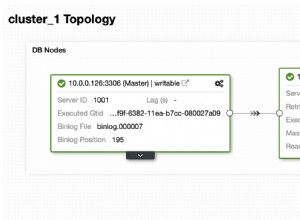Następujące zwróci nazwy kluczy obcych w bieżącej bazie danych, które są wyłączone, tj. Z NOCHECK
Dla SQL Server 2005/2008:
select * from sys.foreign_keys where is_disabled=1
W odpowiedzi była dyskusja na temat różnicy między wyłączonymi a niezaufanymi. To, co poniżej wyjaśnia różnicę. Oto kod wyjaśniający różnicę między is_disabled a isnotrusted.
-- drop table t1
-- drop table t2
create table t1(i int not null, fk int not null)
create table t2(i int not null)
-- create primary key on t2
alter table t2
add constraint pk_1 primary key (i)
-- create foriegn key on t1
alter table t1
add constraint fk_1 foreign key (fk)
references t2 (i)
--insert some records
insert t2 values(100)
insert t2 values(200)
insert t2 values(300)
insert t2 values(400)
insert t2 values(500)
insert t1 values(1,100)
insert t1 values(2,100)
insert t1 values(3,500)
insert t1 values(4,500)
----------------------------
-- 1. enabled and trusted
select name,is_disabled,is_not_trusted from sys.foreign_keys
GO
-- 2. disable the constraint
alter table t1 NOCHECK CONSTRAINT fk_1
select name,is_disabled,is_not_trusted from sys.foreign_keys
GO
-- 3. re-enable constraint, data isnt checked, so not trusted.
-- this means the optimizer will still have to check the column
alter table t1 CHECK CONSTRAINT fk_1
select name,is_disabled,is_not_trusted from sys.foreign_keys
GO
--4. drop the foreign key constraint & re-add
-- it making sure its checked
-- constraint is then enabled and trusted
alter table t1 DROP CONSTRAINT fk_1
alter table t1 WITH CHECK
add constraint fk_1 foreign key (fk)
references t2 (i)
select name,is_disabled,is_not_trusted from sys.foreign_keys
GO
--5. drop the foreign key constraint & add but dont check
-- constraint is then enabled, but not trusted
alter table t1 DROP CONSTRAINT fk_1
alter table t1 WITH NOCHECK
add constraint fk_1 foreign key (fk)
references t2 (i)
select name,is_disabled,is_not_trusted from sys.foreign_keys
GO
is_disabled oznacza, że ograniczenie jest wyłączone
isnottrusted oznacza, że SQL Server nie ufa, że kolumna została sprawdzona względem tabeli kluczy obcych.
Dlatego nie można założyć, że ponowne włączenie ograniczenia klucza obcego zostanie zoptymalizowane. Aby upewnić się, że optymalizator ufa kolumnie, najlepiej usunąć ograniczenie klucza obcego i utworzyć je ponownie za pomocą WITH CHECK opcja (4.)




